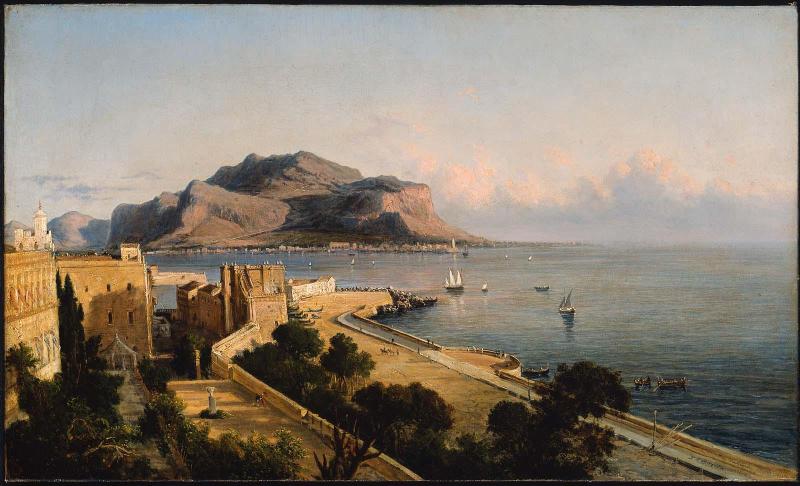Monte Pellegrino at Palermo, Italy
George Loring Brown
(American, 1814–1889)
1856
Medium/TechniqueOil on canvas
Dimensions48.89 x 81.28 cm (19 1/4 x 32 in.)
Credit LineGift of Maxim Karolik for the M. and M. Karolik Collection of American Paintings, 1815–1865
Accession number62.263
On View
Not on viewClassificationsPaintings
Collections
As an aspiring young artist, George Loring Brown visited the island of Sicily for the first time in 1841, possibly as part of a study group of artists from Florence. Fifteen years later, during the summer of 1856, the artist embarked on a three-month long summer trip outside of Rome. He wrote in his account book the day of his departure, "July 1st left for Naples;" the day he returned he wrote, "spent during my absence for traveling expenses and many other objects necessary in my profession--3,000 scudi." During September he visited Palermo, the capital of Sicily, known as "La Citta Felice" because of its semi-tropical climate, great fertility, and exquisite surroundings. There he painted Mount Pellegrino, admired by Goethe a century earlier as a "large rocky mass broader than it is high...its beautiful form cannot be described by words." Monte Pellegrino rises majestically in the Conca d'Oro, "golden shell," in the northwestern end of the bay of Palermo. In ancient times when it was known as Heirkte, Hamilcar Barca held it at siege for three years (247-244 B.C.) during the Punic Wars. But its most important role in the history of the Sicilian city started in 1624 when the remains of a twelfth-century noble girl, Rosalia, were found in a grotto inside the mountain and brought back to Palermo where they miraculously cured a plague. Since that day Saint Rosalia became the patron saint of Palermo, and Mount Pellegrino ("Pilgrim's Mountain") her sanctuary. Brown's "Monte Pellegrino" is a rare subject for an American. He chose to represent it as a backdrop to a peaceful and crisp morning in the marina at Palermo. At the right, next to the coastline, is the Foro Italico--a tree-lined, fashionable esplanade where carriages and citizens leisurely strolled at all times of the day. The Mura della Cative, a twenty-foot-high wall, encloses the promenade and gardens adjoining the seventeenth-century Palazzo Butera (used as the viceroy's quarters during the 1850s). The bird's-eye view used by Brown gives an oblique glimpse of the Porta Felice--one of the main gates of the city. Brown went back to this subject several times, even after he had left Italy.This text has been adapted from N. Otero-Santiago in T. Stebbins, et al., "The Lure of Italy: American Artists and the Italian Experience, 1760-1914," exhibition catalogue, Museum of Fine Arts, Boston, 1992.
InscriptionsLower right: G L Brown/Palermo; Reverse, before relining: Monte Pellegrino at Palermo, painted from Nature, by G.L. Brown, Sep 1856ProvenanceThe artist; Maxim Karolik, Newport, R.I., 1960; to MFA, 1962, gift of Maxim Karolik.
George Loring Brown
1883













